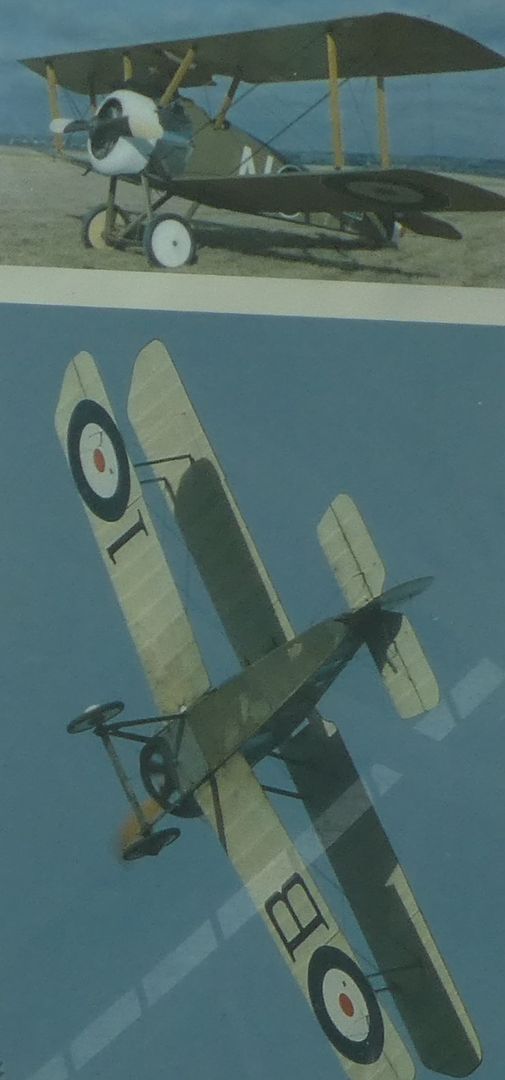The Evergreen Aviation & Space Museum in McMinnville, Oregon, has about 100 aviation and space vehicles on display. Shown below are some biplanes which are on display.
Curtiss JN-4 Jenny (Canuck) (replica)
In 1915, Curtiss combined the best features of the model J and model N trainers and began producing the JN or “Jenny” series. In 1916, eight JN-3s were used in the American invasion of Mexico to fight against Pancho Villa. The success of this expedition led to the development of the JN-4 with orders from both the U.S. Army and the Royal Flying Corps in Canada. The Canadian version of the aircraft, commonly known as the Canuck, had a number of differences from the American version. This aircraft has a cruising speed of 60 mph, a top speed of 75 mph, and a range of 175 miles.


 The Curtiss OX-5 engine, shown above, was designed for the Jenny. This is a V-8 liquid cooled engine. It has 105 horsepower. While 12,600 units of this engine were produced, it was considered unreliable.
The Curtiss OX-5 engine, shown above, was designed for the Jenny. This is a V-8 liquid cooled engine. It has 105 horsepower. While 12,600 units of this engine were produced, it was considered unreliable.
 Another view of the OX-5.
Another view of the OX-5.
De Havilland DH-4
The DH-4 was designed by Geoffrey de Havilland (hence “DH”) as a light two-seat combat aircraft for World War I. It was first flown in 1916 and entered into operational service with the Royal Flying Corps in 1917. Following World War I, many DH-4s were used in Europe for passenger service. The U.S. Post Office also adopted the DH-4 to carry mail. This aircraft has a cruising speed of 104 mph, a top speed of 118 mph, and a range of 470 miles.




Curtiss Model D Headless Pusher
The 1911 Curtiss Model D (often called the Curtiss Pusher) had the engine and propeller behind the pilot’s seat. According to the display:
“It was among the very first aircraft in the world to be built in any quantity—all of which were produced by Curtiss during an era of trial-and-error development and equally important parallel technical development in internal combustion engine technologies.”
This aircraft has a maximum speed of 50 mph and could fly for 2.5 hours.



Wright 1903 Flyer
The Wright Flyer (Flyer I or 1903 Flyer) was the first successful heavier-than-air powered aircraft. To power their aircraft, the Wright brothers calculated that they would need an 8 horsepower engine which weighed no more than 200 pounds. Since no commercially available engines met these specifications, the engine was custom-built at Buckeye Irons and Brass Works with an engine block cast from aluminum to save weight. This aircraft has a maximum speed of 30 mph.




Sopwith F.1 Camel (replica)
The Sopwith F.1 Camel is generally considered the finest British fighter of World War I. The Camel had amazing maneuverability which enabled skilled pilots to make more kills. The Camel entered service in 1917 with both the Royal Naval Air Service and the Royal Flying Corps. This aircraft has a maximum speed of 113 mph and a range of about 300 miles.





Beechcraft Model 17 Staggerwing
The Beechcraft Model 17 was introduced in 1932 and was intended to be a large, powerful, and fast all enclosed biplane built specifically for business executives. Each airplane was hand built with luxurious cabins trimmed in leather and mohair. During its first year of production 18 were built and by the start of World War II, more than 424 had been sold. During World War II, 270 were produced for the U.S. Army Air Force (designated as UC-43) and 106 for the British Royal Air Force and Royal Navy (designated as Traveller Mk. I). This airplane has a cruising speed of 170 mph, a top speed of 180 mph, and a range of 700 miles.



Naval Aircraft Factory N3N Canary
Production of the N3N started in 1935 and ended in 1942. According to the display:
“The N3N was the last biplane in U.S. military service, the last used by the U.S. Naval Academy for aviation familiarization were retired in 1961. The N3N was also unique in that it was an aircraft designed and manufactured by an aviation firm wholly owned and operated by the U.S. Navy as opposed to private industry.”
This aircraft has a cruising speed of 100 mph, a maximum speed of 126 mph, and a range of 470 miles.


More Airplanes
WAAAM: Early Airplanes (Photo Diary)
Museums 101: Experimental Aircraft (Photo Diary)
Museums 101: World War I Airplanes (Photo Diary)
Museums 101: Vintage Aircraft in the Museum of Mountain Flying (Photo Diary)
Museums 101: The Olympic Flight Museum (Photo Diary)
Museums 101: 1930s Biplanes (Photo Diary)
Yanks Air Museum: Biplanes (Photo Diary)
Planes of Fame: Pre-WWII Fighters (Photo Diary)


